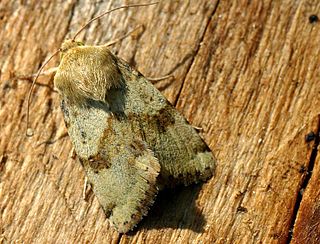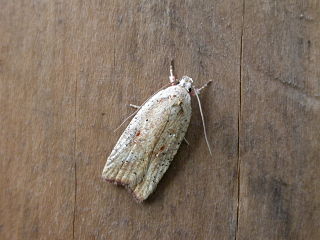
Heliothis viriplaca, the marbled clover, is a moth of the family Noctuoidea. It is found in Europe and across the Palearctic to Central Asia then to Japan, Korea and Sakhalin. In the south, it penetrates to Kashmir and Myanmar. As a migratory moth, it also reaches areas in northern Fennoscandia in some years. North of the Alps, both indigenous and immigrant individuals occur in certain areas. The heat-loving species occurs mainly on dry grasslands, fallow land, heathlands and sunny slopes and slopes and the edges of sand and gravel pits.

The gorse tip moth is a smallish moth species of the family Depressariidae.

Parornix anglicella is a moth of the family Gracillariidae found in Asia and Europe. It was described in 1850, by the English entomologist Henry Tibbats Stainton, from a specimen from Lewisham, Kent.

Pammene regiana is a species of moth of the family Tortricidae. It was described by Zeller in 1849. It is found in most of Europe, except the Iberian Peninsula, most of the Balkan Peninsula, Lithuania and Ukraine.

Epinotia nemorivaga, the bearberry bell, is a species of moth in the family Tortricidae. It is found in Europe and Asia.
Dichomeris carycina is a moth in the family Gelechiidae. It was described by Edward Meyrick in 1914. It is found in Guyana and Brazil.

Dichomeris crambaleas is a moth in the family Gelechiidae. It was described by Edward Meyrick in 1913. It is found in Taiwan and Assam, India.
Dichomeris olivescens is a moth in the family Gelechiidae. It was described by Edward Meyrick in 1913. It is found in Sri Lanka.
Hypatima corynetis is a species of moth in the family Gelechiidae. It was described by Edward Meyrick in 1913. It is found in Sri Lanka.
Hypatima ericta is a moth in the family Gelechiidae. It was described by Edward Meyrick in 1913. It is found in Sri Lanka.
Blastovalva paltobola is a moth of the family Gelechiidae. It was described by Edward Meyrick in 1921. It is found in South Africa.
Depressaria panurga is a moth in the family Depressariidae. It was described by Edward Meyrick in 1920. It is found in South Africa.
Comotechna parmifera is a moth in the family Depressariidae. It was described by Edward Meyrick in 1921. It is found in Peru and Pará, Brazil.
Psittacastis trierica is a moth in the family Depressariidae. It was described by Edward Meyrick in 1909. It is found in Bolivia.
Hypercallia cyathopa is a moth in the family Depressariidae. It was described by Edward Meyrick in 1913. It is found in Colombia.
Antaeotricha chilosema is a moth in the family Depressariidae. It was described by Edward Meyrick in 1918. It is found in French Guiana.

Epinotia abbreviana is a moth of the family Tortricidae. It is found in Europe and was first described by Johan Christian Fabricius in 1794.

Pammene argyrana is a species of moth belonging to the family Tortricidae.
Pammene spiniana is a moth belonging to the family Tortricidae. The species was first described by Philogène Auguste Joseph Duponchel in 1842.

Orthenches dictyarcha is a moth of the family Plutellidae first described by Edward Meyrick in 1927. It is endemic to New Zealand and has been observed at Arthur's Pass and at Hollyford Valley in Fiordland. It is one of the larger species in its genus and is similar in appearance to O. homerica. Its preferred habitat is beech forest and adults are on the wing in January.








